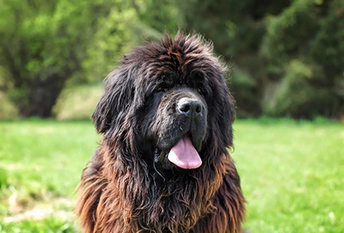Saint Bernards come in two coat types: shorthaired and longhaired. The shorthaired Saint has a dense, smooth coat. His longhaired brother has a medium-length coat that is slightly wavy. Either coat type can be white with red or red with white.
Both varieties shed heavily in spring and fall and need weekly brushing year-round to keep loose hair under control. It’s probably a good idea to brush a longhaired Saint a couple of times a week.
As with all breeds, thenailsshould be trimmed regularly, as overly long nails can be painful to the dog and cause problems walking and running.
Saint Bernards are large and have plenty of calories to burn but should not be over exercised because of potential joint problems, particularly if you have a heavier Saint Bernard under your supervision. Regular exercise is a must to prevent boredom and over-excitement.
With this said, St. Bernard puppies should not be over exercised because their joints and bones are still growing. This includes not letting a dog jump up and down from furniture or going up or down the stairs. Too much pressure placed on their joints and spines at an early age could result in a dog developing problems later in their lives.
For such a large dog, your St. Bernard actually doesnot need vigorous exercise. But because of his size, exercise is important forweight maintenance.
Walks – daily, moderate to long (25 – 60 minutes) walk at a steady pace is fine
Hiking– moderate to long, low-key hikes are great
Runs– adult dogs are OK for short runs (15 – 20 minutes)in cooler temperatures
Dog park (ONLY IF WELL TRAINED, see Things to Know)
Dog sports and training for dog competitions that are not endurance/long-distance runs
Games– this playful dog loves games, they love the interaction with you and the challenge.
You can teach St. Bernard’s more challenging games.
Play indoors if the weather is hot.
When cold, get outside and play, especially if there is snow.
Given that Saint Bernards are so large, they require a similarly large diet in order to maintain healthy body weight. It’s important to remember that this doesn’t mean they should be overfed, however. Plenty of meat and poultry will provide a good caloric intake while vegetables should be mixed in for nutrition.
If you get a St. Bernard puppy from a breeder, they would give you a feeding schedule and it's important to stick to the same routine, feeding the same puppy food to avoid any tummy upsets. You can change a puppy's diet, but this needs to be done very gradually always making sure they don't develop any digestive upsets and if they do, it's best to put them back on their original diet and to discuss things with the vet before attempting to change it again. It's important to get a St. Bernard's diet when they are puppies because it stands them in good stead later on in their lives and the reverse may be true if they are fed incorrectly at a crucial stage of their lives when they are still growing and maturing.
Older dogs are not known to be fussy or finicky eaters, but this does not mean you can feed them a lower quality diet. It's best to feed a mature dog twice a day, once in the morning and then again in the evening, making sure it's good quality food that meets all their nutritional requirements.
Treatscan be an important aid in training, but giving too many can cause obesity. Learn about whichhuman foodsare safe for dogs, and which are not. Check with your vet if you have any concerns about your dog’s weight or diet.Clean, fresh water should be available at all times. Like many large breeds, Saint Bernard can experiencebloat, a life-threatening condition where the stomach distends and twists. The causes of bloat aren’t fully understood, but experts agree that multiple, small meals per day and preventing vigorous exercise around mealtimes may help reduce the chances of it happening.
Saint Bernards typically live between 8 and 10 years. Breed health concerns may include dilated cardiomyopathy (DCM), ectropion, entropion, elbow dysplasia, hip dysplasia, osteochondritis dissecans (OCD), pyotraumatic folliculitis (“hot spots”), cranial cruciate ligament rupture, lymphosarcoma, congenital deafness, epilepsy, eversion of the cartilage of the nictitating membrane, prolapse of the gland of the nictitating membrane (“cherry eye”), lip fold pyoderma, bloat (gastric dilatation and volvulus) and osteosarcoma.
A Saint can handle hot weather as long as he has a cool place to rest and lots of water, but going from air conditioning to high heat can cause serious distress.
Saint Bernards should be raised to socialize with people and animals in order to prevent them from becoming wary of strangers and other dogs. When a Saint Bernard realizes that other people and dogs are simply a part of their life, it will grow up to be rather unassuming and will not be overtly territorial.
Earlysocializationandpuppy training classesare recommended for all dogs but are absolutely required for dogs as big and strong as a St. Bernard.Obedience trainingwill help the Saint learn not to jump on people, knock into small children, steal food from the table, and otherwise take advantage of their size. Saints are kind-hearted and eager to please, so they generally start responding to commands as soon they understand what is expected of them. A Saint wants to be with his family, and undesirable behaviors can result if he is regularly left alone for long periods of time.











